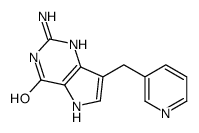133432-71-0
| Name | 2-amino-7-(pyridin-3-ylmethyl)-1,5-dihydropyrrolo[3,2-d]pyrimidin-4-one |
|---|---|
| Synonyms |
2-amino-7-(3-pyridylmethyl)-4-oxo-3H,5H-pyrrolo[3.2-d]pyrimidine
2-amino-7-(3-pyridinylmethyl)-3H,5H-pyrrolo[3,2-d]pyrimidin-4-one 2-amino-7-(pyridin-3-ylmethyl)-3,5-dihydro-4H-pyrrolo[3,2-d]pyrimidin-4-one PELDESINE 2-Amino-3,5-dihydro-7-(3-pyridinylmethyl)-4H-pyrrolo[3,2-d]pyrimidin-4-one 2-amino-7-(3-pyridinylmethyl)-3,5-dihydro-4H-pyrrolo[3,2-d]pyrimidine-4-one BCX 34 9-(3-Pyridylmethyl)-7H-9-deazaguanine Peldesine (USAN) |
| Description | Peldesine (BCX 34) is a potent, competitive, reversible and orally active purine nucleoside phosphorylase (PNP) inhibitor with IC50s of 36 nM, 5 nM, and 32 nM for human, rat, and mouse red blood cell (RBC) PNP, respectively. Peldesine is also a T-cell proliferation inhibitor with an IC50 of 800 nM. Peldesine has the potential for cutaneous T-cell lymphoma, psoriasis and HIV infection treatment[1][2][3][4]. |
|---|---|
| Related Catalog | |
| Target |
IC50: 36 nM (Human RBC PNP), 5 nM (Rat RBC PNP), 32 nM (Mouse RBC PNP), and 800 nM (Human T-cell proliferation)[3] Ki: 23 nM (Human RBC PNP)[3] HIV[4] |
| In Vitro | Peldesine (BCX 34; 0-50 µM; 72 hours; Jurkat cells) could inhibit the T-cell proliferation completely at a concentration of less than 10 μM, in the presence of dGuo (10 μM). In contrast, the B-cell proliferation is not affected by Peldesine[1]. Peldesine (BCX 34) suppresses T-cell immune reaction in an IL-2-independent manner, and this means that Peldesine might affect a late phase rather than an early stage in T-cell activation[1]. Peldesine also, in the presence but not in the absence of deoxyguanosine, inhibits human leukemia CCRF-CEM T-cell proliferation with an IC50 of 0.57 μM but not rat or mouse T-cell proliferation up to 30 μM[3]. Cell Proliferation Assay[1] Cell Line: Jurkat cells Concentration: 0 µM, 10 µM, 20 µM, 30 µM, 40 µM, 50 µM Incubation Time: 72 hours Result: In the presence of 10 µM dCuo, had a complete inhibitory effect for T-cell lines. |
| In Vivo | Oral bioavailability of Peldesine in rats is 76%. Peldesine is orally active in elevating plasma inosine in rats (2-fold at 30 mg/kg), in suppressing ex vivo RBC PNP activity in rats (98% at 3 h. 100 mg/kg), and in suppressing ex vivo skin PNP in mice (39% at 3 h, 100 mg/kg)[3]. |
| References |
[4]. New AIDS study suppresses T cells to stop viral growth. AIDS Alert. 1997 Jul;12(7):77-8. |
| Density | 1.57g/cm3 |
|---|---|
| Boiling Point | 534ºC at 760mmHg |
| Molecular Formula | C12H11N5O |
| Molecular Weight | 241.24900 |
| Flash Point | 276.7ºC |
| Exact Mass | 241.09600 |
| PSA | 101.44000 |
| LogP | 1.16160 |
| Vapour Pressure | 1.76E-11mmHg at 25°C |
| Index of Refraction | 1.794 |
| Storage condition | 2-8°C |
